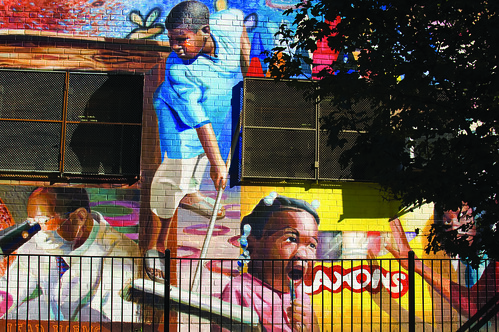In its 25-year history, Philadelphia’s Mural Arts Program has commissioned more than 2,800 murals around the city. The program was founded in 1984 as part of the fight against graffiti, which was plaguing the city at the time.
Numerous new works of art are being dedicated this month as the program celebrates its 25th anniversary.
Each year, tens of thousands of tourists visit Philadelphia, the world’s largest outdoor art gallery for murals.

“[Murals] open up people in the city to a world they would not normally see,” said Kelly Flegal, a freshman art major.
The large number of murals around the city makes it the largest public arts initiative of its kind. Philadelphia earned the title as America’s “City of Murals.”
The program employs more than 300 local and world-renowned artists from diverse backgrounds to paint the murals. Funding for the city’s thousands of murals comes from a $6.8 million budget, which is mostly supported by private donations.
Amy Johnston, public engagement coordinator for the Mural Arts Program, said the murals help communities by “providing access to public art and art education to neighborhoods and young people who might not otherwise have access.”
She added the murals “serve as catalysts for community building and positive change.”
Each year, the program works with about 100 communities to create murals that reflect the culture and diversity of the city’s neighborhoods. The planning process relies on community involvement.
“The murals often become icons and serve as gathering places [in the communities],” Johnston said.
Temple’s Main Campus is surrounded by murals representing prominent community members, sports and history. There is an array of artwork that grace buildings on North Broad Street, like the tributes to Jackie Robinson and Grover Washington, Jr.
“I think it’s great to see art thriving in the city. It’s really unique and inspiring,” said Rob Zangrillo, a freshman art major.
Johnston said the murals help bring “hope and beauty” to the city.
The Philadelphia Anti-Graffiti Network also works to maintain the beauty of local neighborhoods. PAGN provides residents and business owners with free power-wash services to remove graffiti vandalism from their properties. In 1996, the network was reorganized into a nonprofit program.
Cities around the globe are attempting to replicate Philadelphia’s mural program. San Francisco, Venice, Calif. and Chicago have mural arts programs, but not as large as Philadelphia’s.
The Mural Arts Program plans to expand the program to other cities such as: New York, Washington, D.C., Dallas, Detroit, Paris, Dubai and Caracas. More murals are also planned for the city.
“The Mural Arts Program creates an average of 100 to 300 projects annually,” Johnston said. “That means that there are approximately 30 to 40 projects in various stages of development at any given time.”
Matthew D. Wargo can be reached at mdwargo@temple.edu.



Dear Murals Arts Program;
Do you plan on expanding the program to the Seattle area? I would be interested in learning more if you are.
Thanks!
Deb Cuyle